(完整)小学六年级英语总复习资料(开心英语版)
- 格式:doc
- 大小:192.81 KB
- 文档页数:9
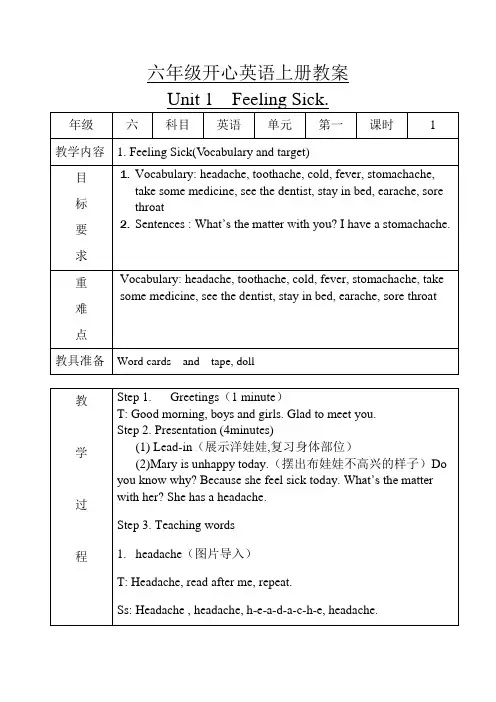
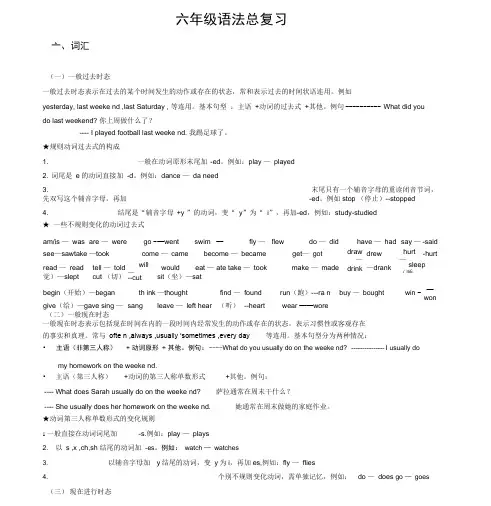
六年级语法总复习亠、词汇(一)一般过去时态一般过去时态表示在过去的某个时间发生的动作或存在的状态,常和表示过去的时间状语连用。
例如yesterday, last weeke nd ,last Saturday , 等连用。
基本句型:主语+动词的过去式+其他。
例句---------- What did youdo last weekend? 你上周做什么了?---- I played football last weeke nd. 我踢足球了。
★规则动词过去式的构成1. 一般在动词原形末尾加-ed。
例如:play —played2. 词尾是e的动词直接加-d。
例如:dance —da need3. 末尾只有一个辅音字母的重读闭音节词,先双写这个辅音字母,再加-ed。
例如stop (停止)--stopped4. 结尾是“辅音字母+y ”的动词,变“ y”为“ i”,再加-ed,例如:study-studied★ 一些不规则变化的动词过去式am/is —was are —were go -—went swim-—swamfly —flew do —did have —had say —-saidsee—sawtake —took come —came become —became get—got draw—drew hurt—-hurtread —read tell —told will—would eat — ate take —took make —made drink —drank sleep(睡觉)—slept cut (切)--cut sit(坐)—satbegin(开始)—began th ink —thought find —found run(跑)---ra n buy —bought win -—won give(给)—gave sing —sang leave —left hear (听)--heart wear ——wore(二)一般现在时态一般现在时态表示包括现在时间在内的一段时间内经常发生的动作或存在的状态,表示习惯性或客观存在的事实和真理。
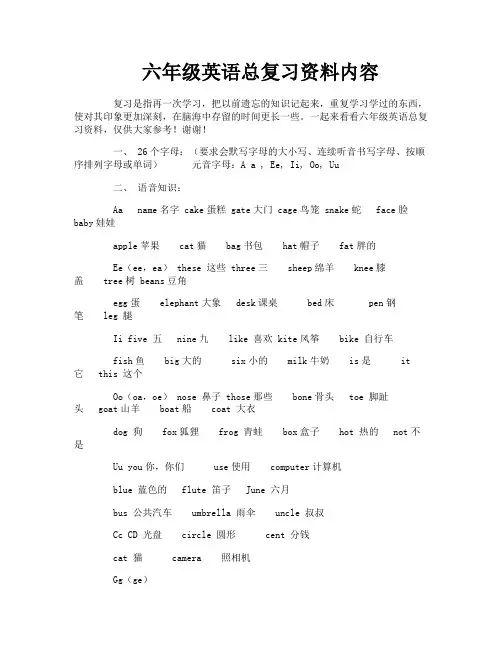
六年级英语总复习资料内容复习是指再一次学习,把以前遗忘的知识记起来,重复学习学过的东西,使对其印象更加深刻,在脑海中存留的时间更长一些。
一起来看看六年级英语总复习资料,仅供大家参考!谢谢!一、 26个字母:(要求会默写字母的大小写、连续听音书写字母、按顺序排列字母或单词)元音字母:A a , Ee, Ii, Oo, Uu二、语音知识:Aa name名字 cake蛋糕 gate大门 cage鸟笼 snake蛇face脸baby娃娃apple苹果 cat猫 bag书包 hat帽子 fat胖的Ee(ee,ea) these 这些 three三 sheep绵羊 knee膝盖 tree树 beans豆角egg蛋 elephant大象desk课桌bed床 pen钢笔 leg 腿Ii five 五nine九 like 喜欢 kite风筝 bike 自行车fish鱼 big大的six小的 milk牛奶 is是it它this 这个Oo(oa,oe) nose 鼻子 those那些 bone骨头toe 脚趾头goat山羊 boat船 coat 大衣dog 狗 fox狐狸 frog 青蛙 box盒子 hot 热的not不是Uu you你,你们use使用 computer计算机blue 蓝色的flute 笛子June 六月bus 公共汽车 umbrella 雨伞 uncle 叔叔Cc CD 光盘 circle 圆形cent 分钱cat 猫camera 照相机Gg(ge)orange 桔子 giraffe 长颈鹿page 页frog 青蛙 girl 女孩big 大的gate 大门th thin 瘦的 three 三thirteen 十三mouth 嘴mother 妈妈 father 爸爸 brother 兄弟 they 他们this 这个 that 那个feather 羽毛whwhat 什么 when 什么时候where 哪里why 为什么which 哪一个white 白色的water水 woman 女人walk 走who 谁whose 谁的ar car 汽车park 公园farm 农场arm手臂 star星星ir girl 女孩bird 鸟nurse护士purse 钱包 turtle 海龟third第三hurt 疼ow cow奶牛owl 猫头鹰house 房子mouse 鼠,鼠标cloudy 多云的oyoi boy 男孩 toy 玩具 oyster 贝壳oil 油coin 硬币 boil 沸腾oroor horse 马 store 商店 corn 玉米door 门floor 地板airear chair 椅子hair 头发 pear 梨bear 熊oobook 书 good 好的 look 看 foot 脚moon 月亮 food 食物pool 池子 room房间字母s或es的发音:字母s在词首发音为/s/, 在中间如:usually, television, treasure, casual中发音为/ /;以/p/, /t/, /k/ 清音收尾,读音为/s/;其他情况一般读音为/z/;以s, x, ch, sh 收尾加es的,es读音为/iz/。
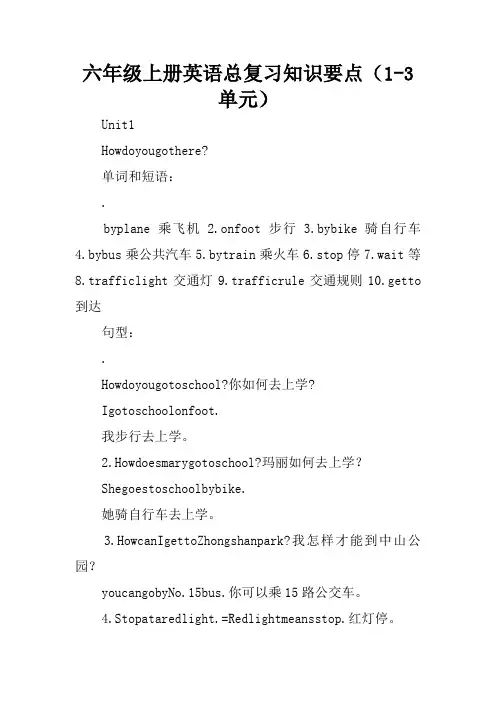
六年级上册英语总复习知识要点(1-3单元)Unit1Howdoyougothere?单词和短语:.byplane乘飞机 2.onfoot步行 3.bybike骑自行车4.bybus乘公共汽车5.bytrain乘火车6.stop停7.wait等8.trafficlight交通灯9.trafficrule交通规则10.getto 到达句型:.Howdoyougotoschool?你如何去上学?Igotoschoolonfoot.我步行去上学。
2.Howdoesmarygotoschool?玛丽如何去上学?Shegoestoschoolbybike.她骑自行车去上学。
3.HowcanIgettoZhongshanpark?我怎样才能到中山公园?youcangobyNo.15bus.你可以乘15路公交车。
4.Stopataredlight.=Redlightmeansstop.红灯停。
5.waitatayellowlight.=yellowlightmeanswait.黄灯等待。
6.Goatagreenlight.=Greenlightmeansgo.绿灯行7.Inchina,driversdriveontherightsideoftheroad.在中国,司机们靠右侧行驶。
(在美国,澳大利亚,香港,新西兰也是。
)Unit2whereisthesciencemuseum?单词和短语:.postoffice邮局 2.hospital医院 3.cinema电影院4.bookstore书店5.sciencemuseum科学博物馆6.bank银行7.library图书馆8.supermarket超市9.excuseme对不起,打扰一下10.apairof一双11.nextto与…相邻12.afterschool放学以后13.north北14.south南15.east 东16.west西17.turnright向右转18.turnleft向左转19.gostraight直行20.lookfor寻找21.please请句型:.whereisthecinema,please?请问,电影院在哪里?It’snexttothehospital.与医院相邻。
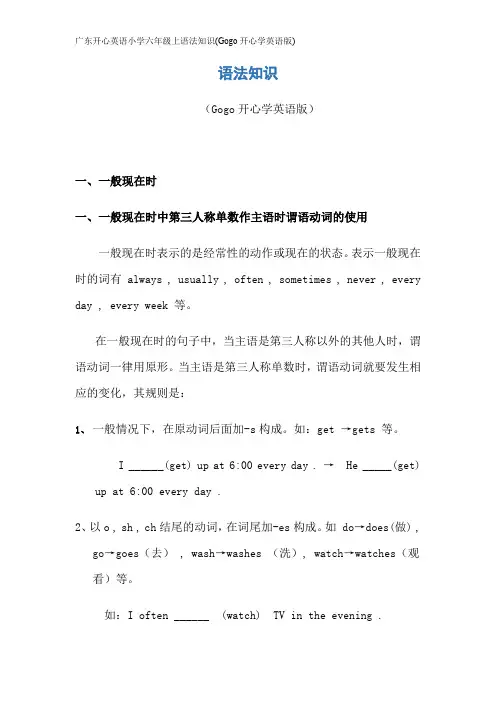
语法知识(Gogo开心学英语版)一、一般现在时一、一般现在时中第三人称单数作主语时谓语动词的使用一般现在时表示的是经常性的动作或现在的状态。
表示一般现在时的词有 always , usually , often , sometimes , never , every day , every week 等。
在一般现在时的句子中,当主语是第三人称以外的其他人时,谓语动词一律用原形。
当主语是第三人称单数时,谓语动词就要发生相应的变化,其规则是:1、一般情况下,在原动词后面加-s构成。
如:get →gets 等。
I ______(get) up at 6:00 every day . → He _____(get)up at 6:00 every day .2、以o , sh , ch结尾的动词,在词尾加-es构成。
如do→does(做) ,go→goes(去), wash→washes (洗), wa tch→watches(观看)等。
如:I often ______ (watch) TV in the evening .→ My mom often ______ (watch) TV in the evening .3、以辅音字母加y结尾的动词,将y改成i 后再加-es 。
如:study→studies 等。
We ________ (study) hard at school . → John _______(study) hard at school .注意:在句子中,如果使用了助动词does , doesn’t , will , won’t , can , can’t , would , wouldn’t , must , mustn’t 等,尽管主语是第三人称单数,谓语动词也不用变化。
如:He doesn’t _________ (want ) to go shopping .Mike won’t __________ ( come ) to school tomorrow .二、现在进行时现在进行时表示现在进行或发生的动作。
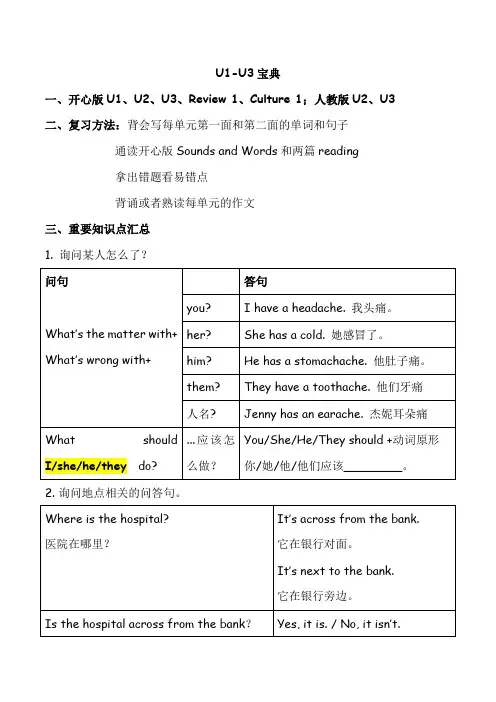
U1-U3宝典一、开心版U1、U2、U3、Review 1、Culture 1;人教版U2、U3二、复习方法:背会写每单元第一面和第二面的单词和句子通读开心版Sounds and Words和两篇reading拿出错题看易错点背诵或者熟读每单元的作文三、重要知识点汇总1. 询问某人怎么了?2.询问地点相关的问答句。
3.询问食物相关问答句。
一般疑问句:Is junk food bad for us? Yes, it is.垃圾食品对我们有坏处吗?是的。
Is plenty of water good for me? Yes, it is.充足的水对我们有好处吗?是的。
Is there enough food for them? No, there isn’t.这里的食物对他们来说足够吗?不,这的不足够。
4.询问动物的种类。
What kind of animals are snakes? They are reptiles.(注意划横线的部分要用复数,fish(鱼类)除外)What animals do you like? I like monkeys. (注意划横线的部分用复数)What animals does he/she like? He/She likes monkeys.*重点:什么动物是什么种类的?它们是_____类动物。
5.询问国家与城市的问答句。
(1)Where do you want to go this winter vacation? 这个寒假你想去哪里?I want to go to + 城市/国家. 我想去_______。
What do you want to do there? 你想在那里做什么?I want to + 动词词组. 我想在那里_______。
询问第三人称时,注意以下的动词变化。
Where does he/she want to go this winter vacation? 这寒假他/她想去哪?He/She wants to go to + 城市/国家. 他/她想去_______。
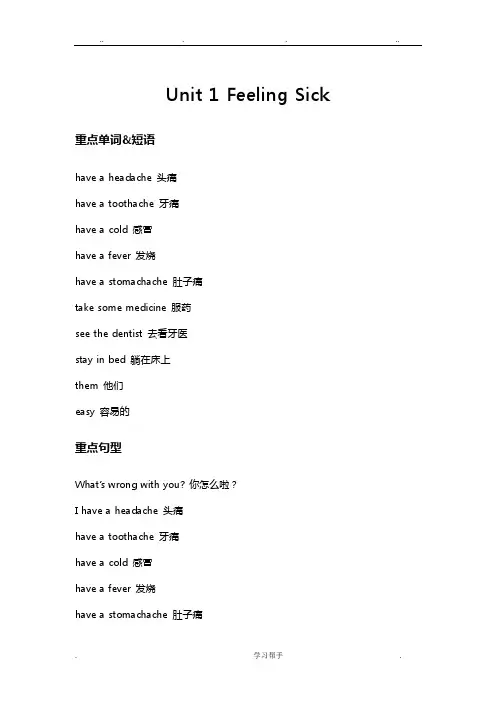
Unit 1 Feeling Sick 重点单词&短语have a headache 头痛have a toothache 牙痛have a cold 感冒have a fever 发烧have a stomachache 肚子痛take some medicine 服药see the dentist 去看牙医stay in bed 躺在床上them 他们easy 容易的重点句型What’s wrong with you? 你怎么啦?I have a headache 头痛have a toothache 牙痛have a cold 感冒have a fever 发烧have a stomachache 肚子痛What’s wrong with him/her/Tony?He/She/Tony has …Please stay in bed.Please take some meidicine.You should take some medicine. You should see the dentist.Please +动词原形should+动词原形课文What’s wrong with you? 你怎么啦?I hurt my foot. 我的脚受伤了。
Let me have a look. 让我看一看。
Be careful next time. 下次小心。
I have a stomachache. 我肚子痛。
Please take some medicine. 请服药。
What’s the matter? 怎么了?I have a cold. 我感冒。
Please stay in bed. 请躺在床上。
What are they doing?他们正在做什么?They’re digging a well. 他们正在挖一口井。
Digging a well? 挖一口井?I can help them. 我可以帮助他们。
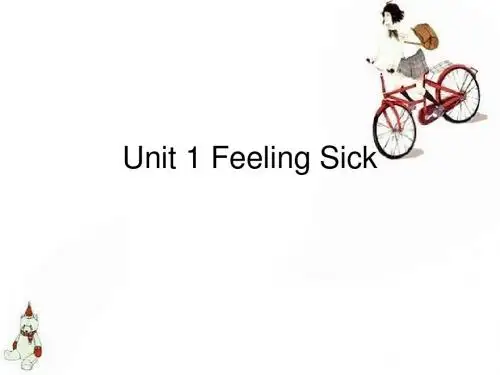
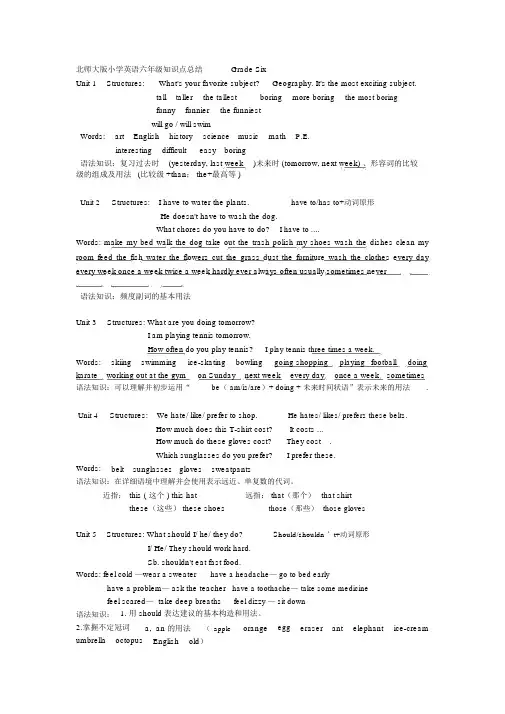
北师大版小学英语六年级知识点总结Grade SixUnit 1 Structures:What's your favorite subject?Geography. It's the most exciting subject.tall taller the tallest boring more boring the most boringfunny funnier the funniestwill go / will swimWords: art English history science music math P.E.interesting difficult easy boring语法知识:复习过去时(yesterday, last week )未来时 (tomorrow, next week) 、形容词的比较级的组成及用法(比较级 +than; the+最高等 )Unit 2Structures: I have to water the plants.have to/has to+动词原形He doesn't have to wash the dog.What chores do you have to do?I have to ....Words: make my bed walk the dog take out the trash polish my shoes wash the dishes clean my room feed the fish water the flowers cut the grass dust the furniture wash the clothes every day every week once a week twice a week hardly ever always often usually sometimes never语法知识:频度副词的基本用法Unit 3Words: karate Structures: What are you doing tomorrow?I am playing tennis tomorrow.How often do you play tennis?I play tennis three times a week.skiing swimming ice-skating bowling going shopping playing football doing working out at the gym on Sunday next week every day once a week sometimes语法知识:可以理解并初步运用“be( am/is/are)+ doing + 未来时间状语”表示未来的用法.Unit 4Structures: We hate/ like/ prefer to shop.How much does this T-shirt cost?How much do these gloves cost?Which sunglasses do you prefer?He hates/ likes/ prefers these belts. It costs ...They cost.I prefer these.Words:belt sunglasses gloves sweatpants语法知识:在详细语境中理解并会使用表示远近、单复数的代词。
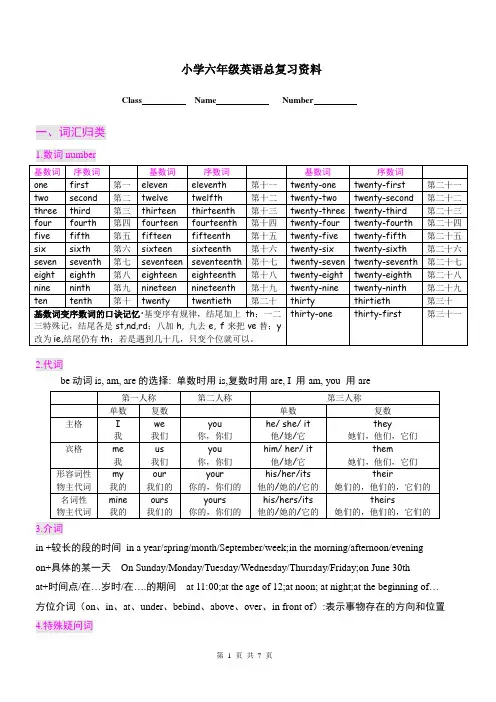
小学六年级英语总复习资料Class Name Number一、词汇归类1.数词number2.代词be动词is, am, are的选择: 单数时用is,复数时用are, I 用am, you 用are3.介词in +较长的段的时间in a year/spring/month/September/week;in the morning/afternoon/eveningon+具体的某一天On Sunday/Monday/Tuesday/Wednesday/Thursday/Friday;on June 30that+时间点/在…岁时/在….的期间at 11:00;at the age of 12;at noon; at night;at the beginning of…方位介词(on、in、at、under、bebind、above、over、in front of):表示事物存在的方向和位置4.特殊疑问词5.同音词I—eye, for—four, where—wear, pear—pair, see—sea, right-- write board—bored, sun—son, hour—our, one—won, here—hear, deer—dear, no—know, there—their, to-- too—two, by-- bye—buy6.缩写形式与完整形式isn’t=is not aren’t=are not I’m=I am it’s=it is can’t=can not could not=couldn’t she’s=she is he’s=he is you’re=you are we’re=we are don’t=do not doesn’t=does not they’re=they are what’s=what is who’s=who is that’s =that is did not=didn’t let’s=let us 二、Let’s spell三、语法点归类1.名词的运用单数名词:一般情况下用a可数名词以元音开头的单词用an (元音字母有:a e i o u)(如:an umbrella/ apple/egg/e-mail/ice cream/orange/umbrella/ elephant)复数名词:一般在词尾加s不可数名词如meat/milk/juice/water/tea/coffee/ soup2.名词单数变复数的规则3.形容词的比较级①形容词比较级的运用:将两个事物或人进行比较要用比较级,句型结构:4.四种时态(一般现在时、现在进行时、一般过去时、一般将来时)⑴一般现在时①用法:表示经常反复发生的动作、存在的状态或习惯性的动作的时态。
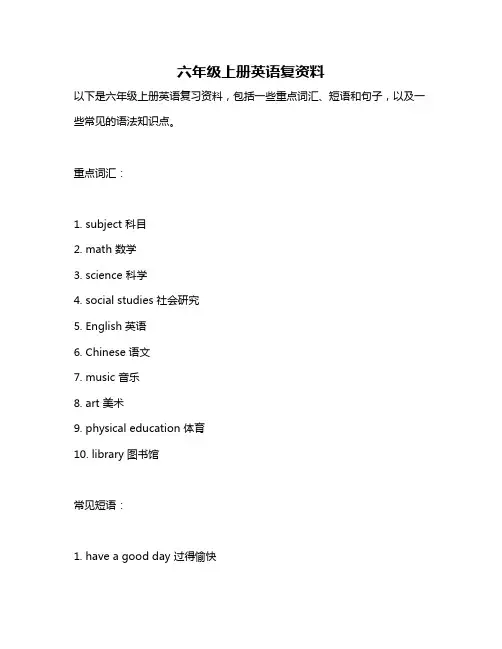
六年级上册英语复资料以下是六年级上册英语复习资料,包括一些重点词汇、短语和句子,以及一些常见的语法知识点。
重点词汇:1. subject 科目2. math 数学3. science 科学4. social studies 社会研究5. English 英语6. Chinese 语文7. music 音乐8. art 美术9. physical education 体育10. library 图书馆常见短语:1. have a good day 过得愉快2. see you later 待会儿见3. have a good time 过得开心4. let me know 让我知道5. have a look 看一看6. have a seat 请坐7. what about you 你呢8. I don’t know 我不知道9. I think so 我认为如此10. I’m not sure 我不能确定常见句子:1. What’s your favorite subject? 你最喜欢的科目是什么?2. I like math because it’s fun. 我喜欢数学因为它很有趣。
3. Do you like science? 你喜欢科学吗?4. Yes, I do. 是的,我喜欢。
5. No, I don’t. 不,我不喜欢。
6. What’s your favorite sport? 你最喜欢的运动是什么?7. My favorite sport is basketball. 我最喜欢的运动是篮球。
8. When do you usually get up? 你通常什么时候起床?9. I usually g et up at 7 o’clock. 我通常在7点钟起床。
10. How many hours do you sleep every night? 你每晚睡多少小时?语法知识点:1. 现在进行时:表示正在进行的动作或状态,结构为“be动词+动词ing”。
人教版 (PEP)小学英语总复习六年级上册知识点Unit1How can I get there ?一、主要单词:museum 博物馆bookstore 书店cinema 电影院turn 转弯hospital 医院left 向左post office邮局science 科学right 向右straight 笔挺地crossing 十字路口二、习惯语搭配:post office 邮局science museum 科学博物馆pet hospital 宠物医院Italian restaurant 意大利餐馆Beihai Park 北海公园Palace Museum 故宫博物院go straight 直走turn right/left 右 /左转next to 挨着in front of... 在 ...前方near the park 在公园邻近on Dongfang Street 在东方大街上三、习用表达式:Unit 2 Ways to go to school一、主要:by 乘bus 公共汽on foot 步行plane 机taxi 出租ship(大)船subway 地train 火slow 慢的stop 停下always 是,向来usually 往常often 常sometimes 有候never 素来不二、搭配:by bike/bus/plane/subway/train/ship/taxi/ferry自行 /乘公共汽 / 机 /地 /火 /船 /出租汽 /渡bus 乘 57 路公共汽on foot 步行slow down 慢下来pay attention to 注意traffic lights 交通讯号灯look right 向右看cross the road横穿路get off下at home 在家traffic rules 交通get to 抵达get on 上be far from⋯表示离某地Excuse me打搅一下Follow me, please! 请随着我!四、公式化句型:1、问路的句型及其答语:问句: Where is the + 地址?···在哪儿?答语: It’s + 表示地址的词语。
(完整版)六年级下册英语知识点总结六年级下册英语知识点总结第一单元(Unit1 How tall are you?)单词:tall—taller更高的short—shorter 更矮的strong—strong更强壮的old—older年龄更大的young—younger 更年轻的big—bigger更大的heavy—heavier 更重的long—longer 更长的thin—thinne更瘦的small—smaller 更小的dinosaur恐龙hall大厅metre,meter 米than比both 两个都kilogram千克,公斤countryside乡村low—lower更低的shadow阴影,影子smart—smarter更聪明的become开始变得,变成句子:1、That's the tallest dinosaur in this hall.那是这个厅里最高的恐龙。
2、You’re older than me. 你比我大。
3、How tall are you ?你有多高?I’m 1.65 metres.我身高1.65米。
4、What size are your shoes ?你穿多大号的鞋?5、My shoes are size 37. 我穿37号的鞋。
6 、Your feet are bigger than mine .你的脚比我的大。
7、How heavy are you ?你有多重?I’m 48 kilograms .我体重48公斤。
8、It’s taller than both of us togethe r .它比我们俩加在一起还高。
应该掌握的知识点:1、形容词变为比较级的变化规则:(1)一般情况下,在形容词的词尾直接加er。
如: tall—taller short—shorter.(2)以字母e结尾的形容词,在词尾直接加r,如:nice—nicer. late—later(3)以重读闭音节结尾,且结尾只有一个辅音字母的词,先双写这个辅音字母,再加er.如:big—bigger thin—thinner fat—fatter(4)以辅音字母加y结尾的双音节形容词,先变y为i , 再加er。
第一节:引言1. 学习英语的重要性在当今全球化的背景下,学习英语已经成为一种基本能力。
我们不仅需要用英语与世界各地的人进行交流,还需要通过英语来获取更多的知识和信息。
学习英语对我们来说是非常重要的。
2. 本文要讨论的主题本文将重点介绍六年级上册开心版英语第三单元的主要内容,包括词汇、语法、阅读和听力练习等方面,以帮助学生更好地学习和掌握这一单元的知识。
第二节:词汇学习1. 本单元的重点词汇本单元的重点词汇包括一些关于家庭成员、食物、动物和颜色等方面的词汇。
学生们需要通过课堂学习和课外复习来掌握这些词汇,并能够正确地运用它们。
2. 如何进行词汇记忆学生们可以通过多次朗读、默写和运用这些词汇来巩固记忆。
老师和家长也可以在日常生活中与学生进行互动,帮助他们在实际情境中运用这些词汇。
第三节:语法学习1. 本单元的语法知识本单元主要介绍了一般现在时的肯定句和否定句的构成形式,以及其相关的动词变化规则。
学生们需要通过练习来掌握这些语法知识,并能够在实际运用中正确地使用它们。
2. 如何进行语法练习老师可以设计一些有趣的语法练习,例如填空、连线和造句等,来帮助学生巩固所学的语法知识。
学生们也可以通过阅读一些简单的英语文章或故事来提高语法运用能力。
第四节:阅读练习1. 本单元的阅读内容本单元的阅读内容主要包括一些有关家庭成员、食物和动物等方面的短文。
学生们需要通过阅读这些短文来提高他们的阅读理解能力,并能够准确地回答相关问题。
2. 如何进行阅读训练学生们可以通过反复阅读、理解文中的内容,并尝试回答问题来进行阅读训练。
老师可以提供一些与短文相关的讨论话题,帮助学生更好地理解和运用所学内容。
第五节:听力练习1. 本单元的听力内容本单元的听力内容主要包括一些关于日常生活和学校活动的对话和短文。
学生们需要通过听力练习来提高他们的听力理解能力,并能够准确地听懂和回答相关问题。
2. 如何进行听力训练学生们可以通过模仿、跟读和听力理解练习来进行听力训练。
部编版小学六年级英语总复习资料(含答
案)
部编版小学六年级英语总复资料(完整版含答案)
此份资料包含小学六年级英语的全面复资料和答案,适用于部编版教材。
以下是资料的内容概述:
一、听力技能
资料中包括了六年级英语中所有的听力材料和练,旨在提升学生听力技能,让他们更好地理解英语。
二、阅读技能
复资料中有大量的阅读材料和题目,包括理解短文、填空、选择、判断等题型,涵盖了六年级英语中的各种语法和词汇知识点。
三、写作技能
资料中共有35个写作任务,每个任务包括了写作指导、范文和练题。
这些练旨在提高学生的写作能力,让他们能够独立地运用英语进行表达。
四、语言知识点
复资料中还包括了小学六年级英语的所有语法和词汇知识点,其中每个知识点都有详细的讲解和例句,并提供了丰富的练题,帮助学生巩固所学知识。
五、完整的答案
资料中提供了所有练题的答案,包括听力练和阅读练、写作和语言知识点的练,方便学生自行核对。
总的来说,此份资料是一份全面、详细的小学六年级英语复习资料,适用于需要全面回顾英语知识点的学生,也适用于备战期末考试的学生。
希望此资料能够帮助到大家。
可编辑修改精选全文完整版六年级英语毕业总复习一单词名词动词形容词可数不可数原型进行式过去式第三人称单数原型比较级apple water do doing did does fat fatter(将来时、一般现在时)(一般现在时)单数复数apple apples一、定义:名词可以分为可数名词和不可数名词,不可数名词没有单复数,一律看作单数。
二、可数名词:分为单数和复数⑴单数:以元音音标a e i o u 开头的单数用an(一个),其他用a(一个)或者one +单数复数:some(一些)加复数或者不可数名词;或者大于1的具体数字+复数⑵可数名词单数→复数的变化规则:三、不可数名词:以下词为常为不可数名词,他们的复数形式就是他们本身。
water 水milk牛奶tea 茶rice米饭juice 果汁bread面包meat 肉四、人称代词:be 动词am , is , are的选择: 单数用is , 复数用are,I 用am , you 用are.练习题一、选择a或an或some.pen bag apple big applebananas orange books water二、写出下列各词的复数.watch _______ child _______ day________ foot________ book_______ sheep ______ box_______ peach______ man______fish _______ paper_______三、选择:1、There on the wall .They are very beautiful.A. are photoesB. are photos2、That’s book.A. anB. a3、There some in the river.A. are, fishesB. are ,fish4. Would you like _______ ,please?A. some watersB. some water5、Do you want to drink much ?A、a milkB、milk四、选择be(am is are ) 填空。
(完整版)小学六年级人教版英语总复习及知识点小学六年级人教版英语总复及知识点(完整版)一、语法知识点1. 时态- 现在时态:用于表示目前正在发生的动作或状态。
- 过去时态:用于表示已经发生的动作或状态。
- 将来时态:用于表示将来要发生的动作或状态。
- 现在进行时:用于表示目前正在进行的动作。
- 现在完成时:用于表示过去某个时间发生的动作对现在造成的影响。
- 过去进行时:用于表示过去某个时间正在进行的动作。
- 过去完成时:用于表示过去某个时间已经完成的动作。
- 将来进行时:用于表示将来某个时间正在进行的动作。
- 将来完成时:用于表示将来某个时间已经完成的动作。
2. 语法结构- 名词:用于表示人、动物、物体、地点等。
- 动词:用于表示动作或状态。
- 形容词:用于描述名词的特征或状态。
- 副词:用于修饰动词、形容词或其他副词。
- 介词:用于表示位置、时间或关系等。
- 代词:用于替代名词。
- 数词:用于表示数量。
- 冠词:用于限定名词的范围。
- 连词:用于连接词语、短语或句子。
3. 句子结构- 主语:句子中执行动作或承受动作的人或事物。
- 谓语:句子中说明主语动作或状态的部分。
- 宾语:句子中接受动作的人或事物。
- 定语:用于修饰名词或代词的成分。
- 状语:用于修饰动词、形容词、副词或整个句子的成分。
- 表语:用于说明主语的状态或特征的部分。
二、总复内容1. 单词- 请根据教材中的单词表,复并牢记相关的单词拼写和意思。
2. 句子- 复教材中的对话和句子,理解并掌握其基本意思和用法。
3. 对话- 复教材中的对话,掌握其中的日常生活用语和表达方式。
4. 语法- 复教材中的语法知识点,加深对时态、语法结构和句子成分的理解。
三、研究方法1. 多听多说- 多听英语教材、歌曲或英语广播,提高听力水平。
- 多说英语,练口语表达和语音准确性。
2. 多读多写- 多读英语教材、故事书等,提高阅读理解能力。
- 多写英语作文,锻炼自己的写作能力和语法运用。
小学六年级英语总复习资料(一)1一、Color (颜色)1. color 颜色2. red 红色(的)3. orange 橙色(的)4. yellow 黄色(的)1. -What color is this? 这个是什么颜色? -It is orange.它是橙色的。
2. -What color are these? 这些是什么颜色?-They are red .它们是红色的。
3. -Look,it’s an apple.It ’s red. 看,这是一颗苹果。
它是红色的。
二、School and School things(学校和学习用品)1. school 学校2. class 教室3. school bus 校车4. chair 椅子5. desk 桌子6. light 电灯7. blackboard 黑板8. card 卡片9. student 学生10.teacher 教师11.lesson 课程12.postcard 明星片13.newspaper报纸 14.dictionary 字典 15.magazine 杂志 16.school bag 书包 17.pen 钢笔 18.pencil 铅笔 19.pencil-case 铅笔盒 20.ruler 尺子 21.eraser 橡皮擦 22.crayon 蜡笔 23.book 书 24.notebook 笔记本 ic book 漫画书 26. story book 故事书 27.Chinese book 语文书 28.math book 数学书 29.English book 英语书 30.sticker 贴纸 31.paper 纸 32.marker 彩色笔 33.sharpener 削笔刀 34.stamp 邮票 35.map 地图 36.picture 图片 37.scissors 剪刀 38.envelope 信封 1.-What this? 这是什么? -It ’s a desk. 这是一张桌子。
2. -And this? 这又是什么? -Oh,it ’s a ruler.Oh ,这是一把尺子。
5.blue 蓝色(的)6.purple 紫色(的)7.green 绿色(的)8.brown 棕色(的)9.pink 粉色(的) 10.black 黑色(的) 11.white 白色(的) 12.gray 灰色(的) 3.-Do you have any crayons? 你有一些蜡笔吗?-No ,I don ’t have any crayons. 不,我没有蜡笔。
4.-Does Jenny have any crayons?Jenny 有一些蜡笔吗? -Yes,she has some crayons.是的,他有。
2三、Sickness (疾病)5. have a headache 头痛6. have a toothache 牙痛7. have a cold 感冒8. have a fever 发烧9. have a stomachache 肚子痛 1. take some medicine 服药2. see the dentist 看牙医3. stay in bed 躺在床上4. see the doctor 看医生四、Family (家庭) 1. family 家庭 2. father 父亲 3. mother 母亲 4.dad 爸爸 5. mum 妈妈 6. brother 兄弟 7. sister 姐妹 8.cousin 堂姐妹 9.uncle 叔叔 10.aunt 阿姨 11.niece 侄女 12.nephew 侄子 13.daughter 女儿 14.son 儿子 15.grandpa 外公16.grandma 外婆17.grandfather 外公18.grandmother 外婆19.parents 父母20.classmate 同学21.friend 朋友5. plane 飞机6. airplane 飞机7. bus 公共汽车8. taxi 出租车五、Body (身体)1. body 身体2. head 头3. shoulder 肩膀4. knee 膝盖5. toe 脚指头6. eye 眼睛7.ear 耳朵 8.mouth 嘴巴 9.nose 鼻子 10.hand 手 11.arm 手臂12.foot 脚13.leg 腿 14.face 脸 15.hair 头发 16.finger 手指 17.tail 尾巴1. -Touch your nose! 触摸你的鼻子!2. -Open your eyes! 张开你的嘴巴!3. -This is my body. 这是我的身体。
4.-These are his arms. 这是他的手臂六、Transportation (交通工具)1. ship 船2. boat 小船3. train 火车4. subway 地铁9.bike 自行车 10.bicycle 自行车 11.car 小汽车3七、Clothes (衣服)1. clothes 衣服2. trousers 裤子3. pants 短裤4. shorts 短裤5. socks 袜子6. skirt 短裙7. dress 连衣裙8. jacket 夹克衫 9. coat 外套 10. sweater 毛衣 11. shirt 衬衫 12. T-shirt T 恤衫 13. cap 帽子 14.hat 帽子 15.scarf 围巾16.boots 靴子17.shoes 鞋子 18.raincoat 雨衣19.tie 领带11.art room 美术室 12.hall 礼堂13.gym 体育馆14.playground 操场 15.corner 角落16.shop 商店 17.countryside 乡村 18.city 城市 19.street 街道 20.hotel 旅店3. -Where ’s my skirt? 我的短裙在哪儿? -It ’s on the bed.它在床上。
4. -Is this your T-shirt? 这是你的T 恤衫吗? -No, it isn ’t.不,不是。
5. -Are these Mom ’s shoes? 这些鞋子是你妈妈的吗? -Yes,they are.是的。
1. -Whose dress is this?这是谁的连衣裙?-It ’s lisa ’s dress.这是Lisa 的连衣裙。
2. -Whose blue socks are these?这些蓝色的袜子是谁的?-They ’re Tony ’s socks. 这些是Tony 的。
八、Home and place (家和地点)1. supermarket 超市2. restaurant 餐馆3. shopping mall 大型购物商场4. hospital 医院5. swimming pool 游泳池6. dining room 餐厅7. teachers ’office 教师办公室8. classroom 教室9. library 图书馆10. music room音乐室 21.home 家22.room 房间 23.house 房子 24.bed 床25.door 门 26.window 窗户 27.dish 盘子28.wall 墙 mp 灯30.bathroom 浴室31.bedroom 卧室 32.kitchen 厨房 33.living room 客厅 34.bank 银行 35.park 公园 36.garden 花园 37.movie theater 电影院 38.zoo 动物园39.beach 沙滩41、-This is my school.这是我的学校。
-There ’s a hall, a gym,a teachers ’ office,a library,an art room,and a music room. 这里有一间礼堂、体育馆、教师办公室、图书馆、美术室、音乐室。
2、-How many classrooms are there?这里有多少间教室?-There are twenty-five classrooms.这里有25间教室。
3、-Is there a living room in your new home?你的新家有客厅吗?-Yea,there is.是的,有呀。
4、-Is there a garden?这里有花园吗? -No, there isn ’t.没有。
5、-Where are you going?你打算去哪里?-I ’m going to the bank.我打算去银行。
6、-Is he/she going to the bank?他/她打算去银行吗?-No,he/she isn ’t.He/She ’s going to the park.不,他/她打算去公园。
7、-Are they going to the beach ?他们打算去海滩吗? -Yes,they are.是的。
九、Animals (动物)9.animals 动物10.cat 猫11.bird鸟 12.dog 狗13.elephant 大象14.panda熊猫 15.monkey 猴子 16.lion 狮子1.duck 鸭子 2.hen 母鸡 3.deer 鹿 4.sheep 羊 5.giraffe 长颈鹿 6.fox 狐狸 7.mouse 老鼠 8.horse 马1、-Is this a panda? 这是一只熊猫吗?-No,it isn ’t./Yes,it is. 不是。
/是的。
十、People and profession (人们和职业)1.people 人们 2.profession 职业 3.boy 男孩 4.girl 女孩 5.Chinese 中国人 6.man 男人 7.men 男人们 8.woman 女人 9.women 女人们17.tiger 老虎 18.rabbit 兔子 19.snake 蛇 20.puppy 小狗 21.fish 鱼 22.cow 奶牛 23.wolf 狼 24.bear 熊21.nurse 护士22.magician 魔术师 23.cook 厨师 24.worker 工人 25.singer 歌手 26.pupil 小学生 27.farmer 农民 28.student 学生 29.driver 司机10.baby 婴儿11.Santa 圣诞老人 12.child 小孩 13.children 孩子们 14.teacher 教师15.firefighter 消防员 16.police 警察 17.writer 作家18.office worker 办公室工作人员 19.doctor 医生 20.dentist 牙医1、-How are you?你最近过得怎样?-I’m fine,thanks.很好,谢谢。